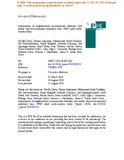Mostrar el registro sencillo del ítem
Associations of neighborhood environmental attributes with adults' objectively-assessed sedentary time: IPEN adult multi-country study
| dc.creator | Owen, Neville | es_ES |
| dc.creator | Sugiyama, Takemi | es_ES |
| dc.creator | Koohsaria, Mohammad Javad | es_ES |
| dc.creator | Bourdeaudhuij, Ilse de | es_ES |
| dc.creator | Aguinaga Ontoso, Inés | es_ES |
| dc.date.accessioned | 2020-11-12T13:59:49Z | |
| dc.date.available | 2020-11-12T13:59:49Z | |
| dc.date.issued | 2018 | |
| dc.identifier.issn | 0091-7435 | |
| dc.identifier.uri | https://hdl.handle.net/2454/38614 | |
| dc.description.abstract | Neighborhood environmental attributes have been found to be associated with residents' time spent walking and in physical activity, in studies from single countries and in multiple-country investigations. There are, however, mixed findings on such environmental relationships with sedentary (sitting) time, which primarily have used evidence derived from single-country investigations with self-reported behavioral outcome measures. We examined potential relationships of neighborhood environmental attributes with objectively-assessed sedentary time using data from 5712 adults recruited from higher and lower socio-economic status neighborhoods in 12 sites in 10 countries, between 2002 and 2011. Ten perceived neighborhood attributes, derived from an internationally-validated scale, were assessed by questionnaire. Sedentary time was derived from hip-worn accelerometer data. Associations of individual environmental attributes and a composite environmental index with sedentary time were estimated using generalized additive mixed models. In fully adjusted models, higher street connectivity was significantly related to lower sedentary time. Residential density, pedestrian infrastructure and safety, and lack of barriers to walking were related to higher sedentary time. Aesthetics and safety from crime were related to less sedentary time in women only. The predicted difference in sedentary time between those with the minimum versus maximum composite environmental index values was 71 min/day. Overall, certain built environment attributes, including street connectivity, land use mix and aesthetics were found to be related to sedentary behavior in both expected and unexpected directions. Further research using context-specific measures of sedentary time is required to improve understanding of the potential role of built environment characteristics as influences on adults' sedentary behavior. | en |
| dc.description.sponsorship | All authors declare financial support for the submitted work from the National Cancer Institute of the United States National Institutes of Health. Data collection in Hong Kong was supported by the HK Research Grants Council GRF grants (#HKU740907H and #747807H) and HKU URC Strategic Research Theme (Public Health). US data collection and Coordinating Center processing was supported by the NIH grants R01 HL67350 (NHLBI) and R01 CA127296 (NCI). The study conducted in Bogota was funded by Colciencias grant 519_2010, Fogarty International Center (NIH) and CeiBA. The contributions of Neville Owen were supported by NHMRC Program Grant #569940, NHMRC Senior Principal Research Fellowship #1003960, and by the Victorian Government's Operational Infrastructure Support Program. The Danish study was partly funded by the Municipality of Aarhus. Data collection in the Czech Republic was supported by the grant MEYS (# MSM 6198959221). Data collection in New Zealand was supported by the Health Research Council of New Zealand grant # 07/356. Data collection in Mexico was supported by the CDC Foundation which received an unrestricted grant from The Coca-Cola Company. The UK study was funded by the Medical Research Council under the National Preventive Research Initiative. Deborah Salvo was supported by a training grant from the CDC Foundation. James F Sallis received grants and personal fees from the Robert Wood Johnson Foundation outside of submitted work, grants and non-financial support from Nike, Inc. outside of submitted work, and is a consultant and receiver of royalties from SPARK Programs of School Specialty, Inc. | en |
| dc.format.extent | 24 p. | |
| dc.format.mimetype | application/pdf | en |
| dc.language.iso | eng | en |
| dc.publisher | Elsevier | en |
| dc.relation.ispartof | Preventive Medicine, 2018, 115, 126-133 | en |
| dc.rights | © 2018 Elsevier Inc. This manuscript version is made available under the CC-BY-NC-ND 4.1 | en |
| dc.rights.uri | http://creativecommons.org/licenses/by-nc-nd/4.0/ | |
| dc.subject | Built environment | en |
| dc.subject | Sedentary behavior | en |
| dc.subject | Adults | en |
| dc.subject | Sitting time | en |
| dc.title | Associations of neighborhood environmental attributes with adults' objectively-assessed sedentary time: IPEN adult multi-country study | en |
| dc.type | info:eu-repo/semantics/article | en |
| dc.type | Artículo / Artikulua | es |
| dc.contributor.department | Ciencias de la Salud | es_ES |
| dc.contributor.department | Osasun Zientziak | eu |
| dc.rights.accessRights | info:eu-repo/semantics/openAccess | en |
| dc.rights.accessRights | Acceso abierto / Sarbide irekia | es |
| dc.identifier.doi | 10.1016/j.ypmed.2018.08.023 | |
| dc.relation.publisherversion | https://doi.org/10.1016/j.ypmed.2018.08.023 | |
| dc.type.version | info:eu-repo/semantics/acceptedVersion | en |
| dc.type.version | Versión aceptada / Onetsi den bertsioa | es |



